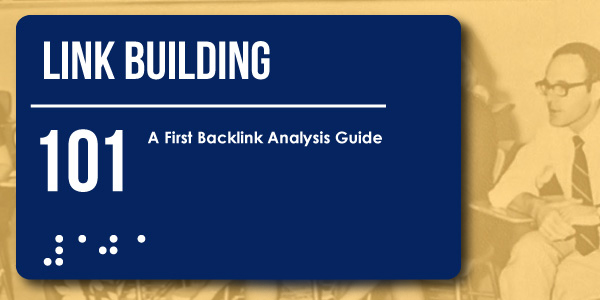
Every day, individuals who are new to SEO need to learn the basics of link building and important concepts and strategies within a campaign. This link building 101 post will continue the education of new link builders, this time on the topic of how to perform a backlink analysis
Being able to perform a thorough backlink analysis is a fundamental element to any link building campaign. What’s more, running backlink analyses can help develop your fundamental knowledge of links, link building strategies, and link quality.
What are the elements of a thorough backlinks analysis:
- Total number of links
- Number of unique domains
- Linking domains vs total links
- Anchor text usage and variance – branded, keyword rich, etc.
- Fresh/incoming links
- Page performance
- Link quality*
*Learned only by experience, running multiple backlink analyses, and manually checking links.
The Importance of Link Portfolios
A link portfolio (or profile) is a fancy way of saying all the sites currently linking to your site. Links matter. Big time.
So, when you run a backlink analysis on a site – whether it’s your own or a competitor’s – you’re looking at the websites linking to that website, in what manner, and to what page.
And, since we understand Google’s algorithmic reliance on links, we know that a website’s ability to rank in Google is largely dependent on the websites linking to it (i.e., its backlink portfolio).
So, before you can even begin to consider a link building campaign you need to understand the site’s current link portfolio. There are a variety of tools to help you along this path:
All of these tools will do the job properly, and choosing one mainly comes down to a matter of preference. If possible I would recommend using two or more of these tools to ensure you’re getting as much information as possible.
Currently I use Open Site Explorer and MajesticSEO, so the walkthrough will be based largely on the use of these two tools, and the screenshots you see will be pulled from these as well.
Getting Started
To start, you simply go to your chosen tool’s website and plug in the target website’s URL. This will immediately take you to an overview page, in which the target website’s backlinks are summarized in full.
I highly recommend that if this is your first time ever using a backlink explorer, you take 30 minutes to an hour and simply click around and familiarize yourself with the various tabs, graphs, functions, filters, etc.
Being comfortable with the tool is extremely important in understanding the data it can reveal, as well as the implications therein.
Once you’ve acclimated to your new SEO tool, the first element you should analyze of the site’s backlink portfolio is the total number of links.
1. Total Number of Links
Open Site Explorer:

This will be at the top of your screen once you’ve searched the URL. Red highlight is mine.
Majestic Site Explorer:

Once again, highlighted in red.
(Note: there’s a large discrepancy here. Majestic commonly reports more links than Open Site Explorer, but in this case it seemed to be picking up some recent ads as links, creating a large inflation.)
Understanding total link count is a good start to understanding how competitive a website is currently (especially if you’re looking at competitors link counts, too). However, it’s easy to spam a high link count with tactics such as sitewide links, article directories, blog comments, etc. So, total links definitely doesn’t correlate to a strong link profile, or high rankings.
The next step, which helps understand link quality, is to check the number of linking domains as well.
2. Number of Unique Domains
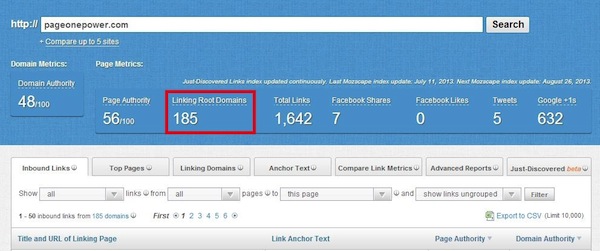
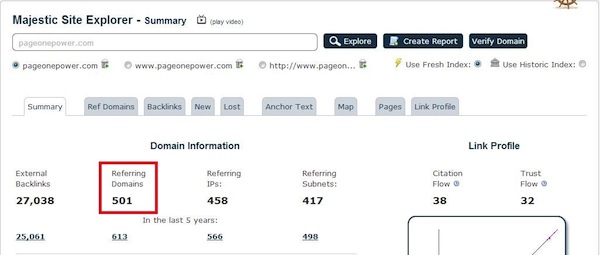
Unique domains are typically a better metric than link count, since multiple links from the same domain are typically considered to have a drop off in value.
Of course other factors weigh in, such as site relevance, quality, anchor text, link placement, etc. Still, looking at top-level metrics you want to ensure you’re analyzing linking domains as well as total links.
3. Linking Domains vs. Total Links
Linking domains versus total links is done by simply comparing the two numbers we’ve taken a look at thus far. If you have thousands upon thousands of links per linking domain, that could definitely be a red flag for an unnatural link portfolio. And again, it’s accepted that link value drops off as you accumulate more and more links from a single domain.
The goal should be to have as even a ratio as possible when comparing unique domains versus total links, although obviously there will always be considerably more total links than linking domains. A single site-wide link can quickly inflate this ratio, and should be something to look out for and avoid when it makes sense.
4. Anchor Text Usage and Variance
For Open Site Explorer we click on this tab:

This tab displays a list of anchor text terms, the number of linking domains using that specific anchor text, and the number of total links using that anchor text.

For Majestic:
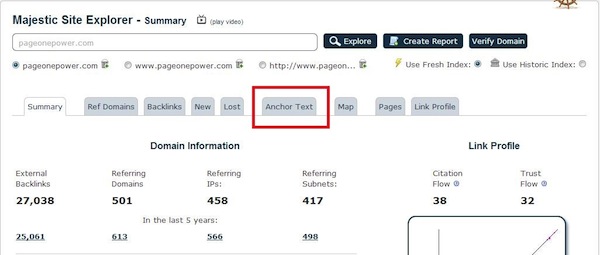
Majestic will also provide you with a list of anchor text complete with linking domains, total links, along with trust metrics.
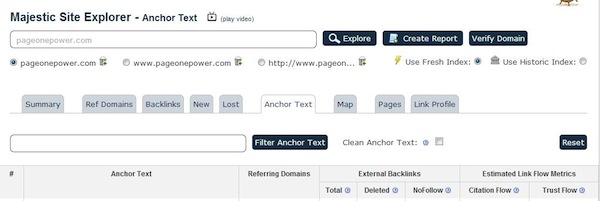
Alternatively, you can also flip to Majestic’s summary tab, which will actually have an anchor text graph available:
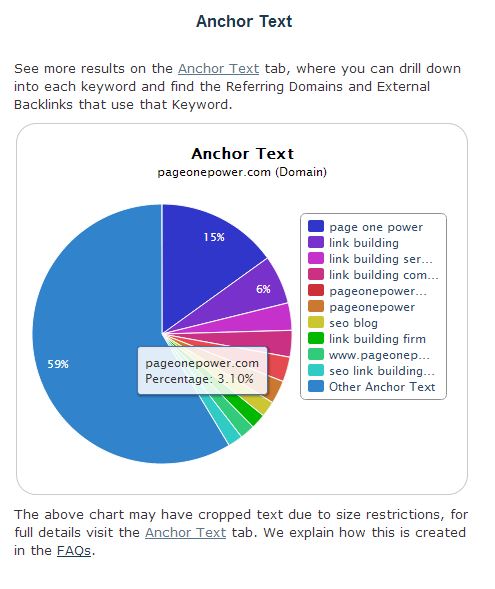
There are two things you should be looking for when you’re examining anchor text – usage and variance.
First, you can tell based upon links which keywords have been optimized (and potentially over optimized). Doing a quick search in Google based upon the link anchor text should tell you how a site is performing, and reveal potential insights.
Once again, diversity is key here. Although many link builders used keyword rich anchor text (i.e., “dog beds” or “diesel generators”) as the link in recent years, with the implementation of Penguin 2.0 it’s more important than ever before to ensure diversity and branding (i.e., your brand name instead of the money keyword you want to rank for).
Understanding the current anchor text portfolio for a website is extremely important before launching a campaign – you want to ensure that branding is by far the largest piece of the pie, and that any keyword rich anchor links are used intelligently.
Furthermore, you can make sure to avoid anchor text that’s already been overused, and implement other anchor text that’s been underutilized.
5. Fresh/Incoming Links
Once again there are tabs within both Open Site Explorer and Majestic that will show you fresh or recently discovered links:
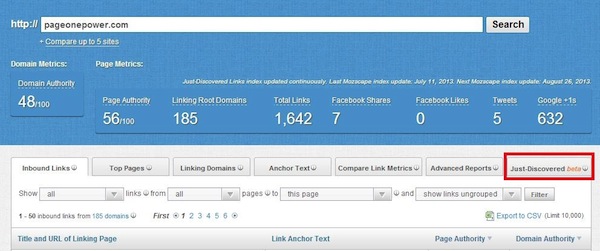

Both of these tabs sort by newest found and display their native link data. Majestic also displays a handy graph for quick reference and monitoring incoming links by day or date range:

Fresh link data is important for several reasons – you can see recent links built which can let you decipher current/recent strategies, if suspicious link building activities are underway, and generally notice any unaccounted for large spikes in link velocity (amount of links built in a short time).
I would definitely say that seeing thousands – or even hundreds – of links built per day would raise a red flag, unless the website in question is sizable and well known.
Again, fresh links is a great metric to check if a change in ranking has happened recently. Although often Google’s algorithm and subsequent actions are outside of our control, we should always be aware what’s going on with our own sites as well as competitors.
6. Page Performance
Here is where we look into the breakdown of links per page, and see which pages currently have the most links.
This is extremely important in understanding current site performance, especially for various resource pages. This can help guide discussion about underperforming pages, pages that are currently doing well (and perhaps why), and where the focus of a link building campaign should or should not be.
A couple screenshots of with the page tab highlighted:
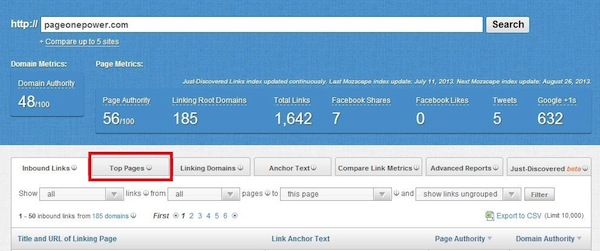
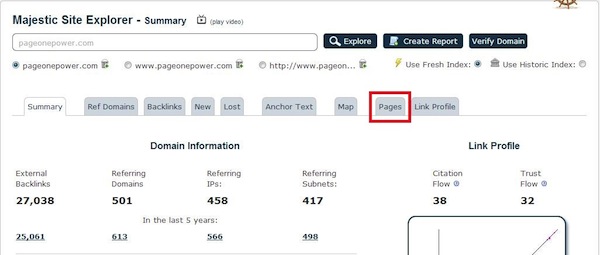
Clicking over to these tabs will give you a list of the top link grossing pages per site, from largest to smallest.
Typically the home page will be number one. The top linked pages feature is absolutely great for quickly finding previous wins and shedding a little light on what might work well and prove linkable within a vertical.
I’ve also found it to be an absolutely great metric to break down competitor wins – you can see what resources they’ve created that have resulted in high link counts, and use that to brainstorm resource creations of your own.
7. Link Quality
This is the time I spend manually clicking around, exploring links, and simply checking everything out. Usually it’s only a thirty minute endeavor to make sure I’m working beyond the tools, and have truly dived into some of the data.
Sure, it’s nice to have various tools helping you understand a website’s link portfolio, but in all honesty if you’re not spending some time manually examining links yourself, you’re missing the point.
Here’s what I generally look at when checking out link quality:
- Relevance – including the site, page, and link.
- The domain author/Page Rank of the site and the page authority/Page Rank of the page (assuming the relevance checks out).
- The placement of the link – natural versus shoe-horned, helpful for the user versus obvious link building, etc.
- The anchor text.
- The overall believability of the link – how editorial does it seem?
As you spend time working on link building campaigns and examining backlinks you’ll find there’s a natural instinct that lets you know when a link is good and when a link is bad. Obviously, spam itself is easily identifiable. Link sense can develop well beyond that, however, and help you find suspicious links that can fool tools. Often we refer to this as the smell test – because you know when a link stinks.
Taking this All to Excel
All of this data from each tab can be exported into excel as CSVs for further revelations and extrapolations. This gets a bit more advanced, but is a must if you’re going to be doing a comparison of multiple sites, or wish to do a competitive analysis with your site and a competitor.
Here’s a great guide on competitor backlink analysis in Excel. Here’s another advanced guide using Open Site Explorer and link intersect – definitely worth a read if you’re looking to learn competitive analysis. And finally, three phenomenal Excel spreadsheets for link analysis.
There are many guides that can walk you through how to export this data, combine each into an Excel spreadsheet, and even do a competitive analysis.
It’s definitely worth exploring, but a bit more than I can go into detail here. It’s also a bit more advanced, so make sure you’re comfortable with backlink audits and analysis before you being exporting it all to Excel and playing around.
Recap
Backlink analysis is one of the first skills you should learn as a budding SEO practitioner and link builder. Being able to confidently dive into your website’s (or a competitor’s) link profile will help you learn more about the SEO industry and gain much needed experience.
For basic analysis, you should be looking at:
- Total number of links
- Number of unique domains
- Linking domains vs total links
- Anchor text usage and variance
- Fresh/incoming links
- Page performance
- Link quality
There are so many possible opportunities for insight within a backlink analysis. You can learn:
- Competitor’s link building strategies
- Competitor’s top performing resources
- Underutilized link opportunities with your own site
- Viable link strategies within your industry
- Over-optimized anchor text
- Links that need to be removed
- Etc.
So go get your hands dirty and dive into your first backlink analysis today!














